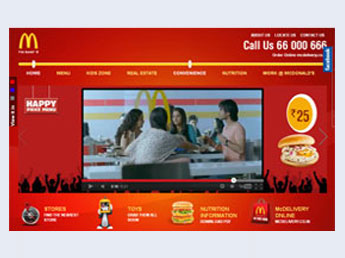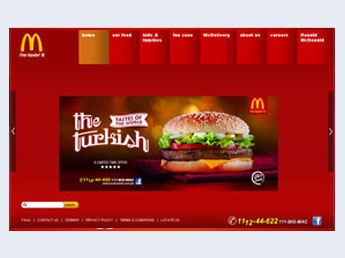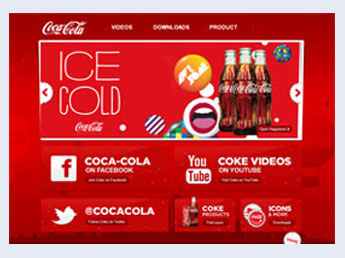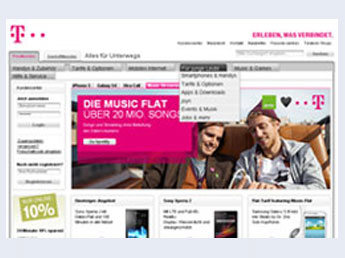- About us
- Contact us: +1.641.472.4480, hfi@humanfactors.com
Cool stuff and UX resources
Standardization vs. Localization
A couple of weeks ago, while doing some cross-cultural research on websites, I stumbled onto several McDonald's’ websites in different countries. It was particularly striking that each of the sites was radically different, not just in terms of text and translation, but from the kind of images used, typography selected, color palettes designed, layouts chosen, to even the favicons!
As I looked at more examples from different countries, it appeared that the European websites were more similar visually when compared to the set of Asian websites. While I debated whether it was a good design strategy or stereotyping of cultures, it was clear that McDonald's felt it was important.
On the one hand, the user interface design process focuses wholly on the user and his context ‚ÄĒ his needs, wants, expectations and preferences ‚ÄĒ and on the other hand, global businesses want to cater to and engage with consumers across the world and consider demographic diversity which, while possible, can get very complicated.
Imagine your favorite e-commerce website being visited by users from different parts of the world, assuming that language translation is successful; are there elements of it that might make it difficult for them to navigate through the site? Are there metaphors that they simply would not understand? How about mental models; do users from different cultures look for different data to make decisions? There are several other questions that illustrate the depth of this problem. But the bottom line is to help make communication effective between a global business and a local user. It simply isn’t enough to use a standardized website that translates the text and utilizes the same images, layout and color of the parent site (Becker and Crespo, 2001). For instance, consider the OK gesture; in most English-speaking countries, it is a sign of everything working well, but in several European countries the same gesture means “zero” or “worthless.”
The debate around standardization versus localization in website design continues to be a bone of contention. While some argue that due to the nature of the internet, cultural distance will minimize and we will see a homogeneous online culture. Many other research studies show that consumers prefer to visit and interact with sites that are made specifically for them and which contribute to online customer trust, satisfaction and e-loyalty (Cyr, 2004). Even so, the goal of culturally sensitive usability is to understand different cultural perspectives holistically with the user-centered design approach, and to avoid stereotyping cultures or making tacit assumptions about politically correct design.




Research on cultural differences
Much research around cultural differences has been published. Few of these works are well known, with particular focus on Fons Trompenaars and Geert Hofstede’s work.
Trompenaars, a prolific Dutch researcher in the field of cross-cultural communication, with Hampden-Turner, studied how people from different cultures solve problems. Hofstede, an influential Dutch cultural anthropologist and psychologist, conducted extensive and exhaustive interviews with IBM employees in 53 countries in the early 1970s, with over 100,000 data points. Both Trompenaars and Hofstede discovered that there were significant differences among cultures in different countries. Both went on to define culture as a set of shared characteristics such as thoughts, values and behaviors. Based on their research, Trompenaars and Hofstede formulated different theories on cultural dimensions, which defined sharp lines of distinctions along which cultures differ.
Given the global platform of the Internet where social experiences are shared and communal interaction occurs, it becomes critical for web and web-based application design to consider culturally diverse user groups. While some fundamental principles of usability, such as simplicity and consistency, are elemental, in such situations there are certain design characteristics that need to be reflected upon.
According to Cyr (2004), there are critical characteristics of design that need attention in a cultural context:
- Language, which is a distinctive aspect of different cultures, which when moved to the online domain presents its own challenges of quality of translation, representation and stylistic elements.
- Layout that serves as a communication bridge between the user and the system, it involves placement of banners, menu items, orientation, amongst others.
- Symbols refer to “metaphors” denoting actions for the user and vary from culture to culture. They may be icons used for currencies, locations, and other navigational elements.
- Content or structure, referring information or features that the site offers and its organization.
Navigation that is easy to use and facilitates access to information. - Multimedia, including video, animation, images and sound.
- Color ‚Äď where color semiotics varies across cultures and can impact user expectations.
Hofstede’s Five Dimensions
The concept of culturally sensitive design includes all these characteristics as well as the emotions, behaviors and ways of thinking of the individuals also considered as users (Eristi, 2009). As per Eristi, Hofstede’s cultural dimension theory seems to be effective in the culturalization process of appeal in web design.
According to Hofstede (1980), world cultures vary across certain consistent and fundamental values. These 5 dimensions are:
- Power distance
- Collectivism vs. individualism
- Femininity vs. masculinity
- Uncertainty avoidance
- Long vs. short-term orientation
Marcus and Gould (2000) make several inferences from Hofstede’s theory and how it can be adapted to cultural differences. Scientists have continued to build upon their work, creating many ‘best’ practices for cross-cultural interface design.
Let’s take a very brief look at each of Hofstede’s dimensions and preliminary implications for user-interface and web design to make design characteristics culturally relevant:


Power Distance (PD)
This is the extent to which less powerful members of organizations accept that power is distributed unequally. High power distance countries are more autocratic; low power distance countries are more democratic.
Implications:
Marcus and Gould mention that high power distance countries have a stronger focus on expertise, authority, experts, certifications, official stamps and logos, amongst others. Access to information is restricted and social roles are used to organize information (managers’ section vs. non-managers’ section).
- Introducing visuals, expressions, images with authoritative body language, that are informative and guiding will work well in high power distance countries. Low power distance cultures may prefer activities of daily life, popular images, symbols and colors.
- Clear indicators of navigation that present all information at once are appreciated in high power distance countries, whereas less dense and informally organized structure is preferred in low power distance countries.
- High power distance cultures tend to prefer sites with a formal layout but with more vivid visuals. Limited choices and restricted access to information is favored. Visual elements that are resonant with the pulse of the nation are valued.
- Low power distance countries prefer informal layouts with clear access, and multiple choices on use. Flexible interactions that guide in case of errors will be valued. Visual elements that are more universal are preferred.
Kuwait has an index of 90 on the dimension of power distance, meaning that it values hierarchy, top-down direction and centralized power. The information architecture is very organized with very little information for the press or the presence of a media center. There are very few choices people can make. It has a formal layout but can look “flashy” with the overbearing presence of red. The images used are powerful and used to guide the user into the site.
Ireland has a lower power distance index of 28. They value informal structures where hierarchies are not maintained very strictly. The Coca-Cola Ireland site is very transparent in sharing information. The information architecture is shallow and clearly surfaced. Search functionality is provided for multiple choices on use and the site encourages exploration.
Individualism vs. Collectivism (IDV)
This refers to the degree to which individuals are integrated into groups. Individualistic societies emphasize personal achievements and individual rights. Collectivist societies emphasize group affiliations and loyalty.
Implications:
In the same paper, Marcus and Gould (2000) believe that motivation is based on personal achievement in individualistic cultures, while collectivist societies value harmony and consensus to move forward.
- Content based on materialism and consumerism will work well in individualistic cultures, and those that represent community and harmony will work better in collectivist societies.
- Language, sound, videos and metaphors that emphasize individual successes will be preferred in high IDV countries; with larger successes and goals will matter more in low in IDV cultures.
- Individualistic countries will value importance given to the youth, whereas social actors of experience and wise leaders will be preferred in collectivist cultures.
- Sites that offer extrinsic rewards tend to be valued by cultures that are highly individualistic.
With a score of 76 on the IDV index, Italy is a very individualistic culture. Personal achievement and a sense of self are important and this is highlighted in the Italian version of Match.com. Only one image is used and portrays a young couple emphasizing the importance of youth.
Venezuela has a score of 12, and is among the most collectivist societies in the world. There is a high preference for belonging to a larger group and people are expected to be virtuous and act for the greater good. In the Venezuelan site for Match.com, this is reflected clearly with the number of people both young and middle-aged shown in the background. They represent community and harmony which is important to collectivist societies.




Femininity vs. Masculinity (MAS)
This talks about the distribution of emotional roles between genders. Masculine cultures are competitive, assertive, materialistic; feminine cultures place more value on relationships and quality of life.
Implications:
High masculinity cultures place importance on traditional gender, family and age distinctions, whereas feminine cultures emphasize the blurring of gender roles.
- Visuals with a feminine theme including family will be preferred in highly feminine countries, and male dominated cultures will prefer images related to competition, meetings, success, personal gratification, etc.
- Symbolic indicators and metaphors of achievement, results, and objectives will be preferred in high MAS countries, whereas social activity and interaction will be valued in low MAS cultures.
With a MAS score of 79, Austria is a high masculinity culture. The society is decisive, and values success and personal gratification. This is seen in the KFC Austria site, where winners and dreams are clearly surfaced on the homepage.
On the other hand Denmark has a score of 16 on the scale, making it a feminine culture. Such societies value caring for others and quality of life. The KFC site for Denmark makes an apparent differentiation with the softer colors and feminine icons and metaphors. The homepage highlights the video where social activity and caring for society is prominent. The visuals used also suggest consuming the meal with friends.
Uncertainty Avoidance (UA)
This refers to the degree of tolerance for uncertainty and ambiguity. High uncertainty avoidance cultures are more emotional, and control changes with rules, laws and regulations. Low uncertainty avoidance cultures are more pragmatic, and have as few rules as possible.
Implications:
Cultures with high uncertainty avoidance would emphasize simplicity, clear metaphors, limited choices and restricted amounts of data, according to Marcus and Gould (2000).
- Content and visuals that are clear and concretely associated with lives of individuals will be preferred greatly by high UA cultures. More general and symbolic messages with less detail will be valued by low UA cultures.
- Redundant cues in color and typography that increase ambiguity are shunned by cultures with a high uncertainty avoidance index. They prefer very clean and distinct choices.
With a score of 112, Germany is one of the countries that fall high on uncertainty avoidance. According to Hofstede, given their philosophical heritage, they have a strong preference for deductive rather than inductive reasoning. A systematic overview needs to be given in order to proceed. The T-Mobile site provides plenty of information; visuals clearly indicate the message, and typography and colors cues are not redundant and help reduce ambiguity.
Singapore has a score of 8 on the UA index meaning that people maintain decorum and follow rules but not because of the need for a structure but because they fall high on the power distance index. Messages on the T-mobile site are very clinical. The information architecture is very shallow, not dense with detail. Several links are repeated many times within the homepage.




Long vs. Short-term Orientation (LTO)
This refers to the time horizon of a society. Long-term oriented societies are oriented to the future, and are pragmatic, rewarding persistence and saving. Short-term oriented societies are oriented to the present and the past, rewarding reciprocity in social relations and the fulfilling of social obligations.
Implications:
High LTO countries would value relationships as a source of information and credibility and content that is focused on practical value, whereas low LTO countries would prefer content based on truth, desire for immediate results and achievement of goals.
- Content and visual elements that are focused on rules as a source of credibility are valued more in low LTO countries whereas high LTO cultures are oriented by the search of virtuous behavior.
- Content and navigation that emphasize long-term development and goals of the business will be valued by high LTO cultures. Providing future plans and guiding the users to understand their future relationship with the brand will be greatly appreciated by high LTO cultures. Other symbolic indicators that focus on immediate gratification will be favored by low LTO countries.
With a score of 118 on the short-term vs. long-term orientation, China is one of the most long-term orientation cultures in the world. They value virtuous behavior and long term planning and commitment. For example, the information architecture of the site has surfaced their CSR initiatives on the homepage. The visuals and their slugs talk about responsibility, reciprocity and efficiency to create a better world.
On the other hand, the United Kingdom is one of the most short-term orientation cultures in the world. For example, Wrigley’s UK website clearly focuses on small but immediate gratification with the tagline in the image. The news aggregator widget mentions everything that’s new and so do the other images at the bottom. The layout is very clean and organizes information to allow the easiest access to information.
Conclusions
It is interesting to note how each of these dimensions can have a considerable effect on global web design. From shallow vs. deep information architectures, access to information, motivation and trust, security and personal information, navigation, simplicity, graphical elements, to even color, among others.
This becomes especially important in contemporary settings when e-loyalty is critical in online transactions, and visual appeal is one of the ways to increase trust. Human beings instinctively make snap judgments about everything they see and try to rationalize it afterward, and so it becomes essential to get a positive first impression.
The idea of website globalization has two complementary processes. As per Periera and Singh (2005), globalization consists of website internationalization and website localization that work in tandem. While internationalization refers to the back-end processes of creating modular and accessible global website templates, localization refers to the front-end customization where websites are adapted to meet expectations of a culturally diverse user group.
In the e-commerce environment especially, the market is truly global even for a start-up. It is necessary to have a framework that allows cross-cultural design and usability as part of the development life cycle of any website. There will soon be a need for creating tools that allow for cultural versioning to suit global businesses and their agenda to communicate effectively to the local user. Involving cultural factors in the design process increases the aesthetic value, perceivable quality and behavioral intention in the users.
References
-
Primary References:
- Cyr, D. (2008). Modeling Web Site Design Across Cultures: Relationships to Trust, Satisfaction, and E-Loyalty.Journal of Management Information Systems.
- Eristi, S. (2009). Cultural Factors in Web Design. Journal of Theoretical and Applied Information Technology.
- Marcus, A., & Gould, E. (2000). Cultural Dimensions and Global Web User-Interface Design: What? So What? Now What?
Secondary References:
- Cyr, D., & Trevor-Smith, H. (2004). Localization of Web Design: An Empirical Comparison of German Japanese and U.S. Website Characteristics. Journal of The American Society for Information Science and Technology, 55(13) 1-10.
- Cyr, D., Bowes, J., Budd, J., & Ilsever, J. (2003). Managing E-Loyalty Through Experience Design: Cross-Cultural Perspectives.
- Smith, A., Dunckley, L., French, T., Minocha, S., & Chang, Y. (2004). A process model for developing usable cross-cultural websites. Interacting with Computers.
- W√ľrtz, E. (2005). A Cross-cultural Analysis of Websites from High-context Cultures and Low-context Cultures. Journal of Computer-Mediated Communication, 11(1), article 13.
Message from the CEO, Dr. Eric Schaffer ‚ÄĒ The Pragmatic Ergonomist
Leave a comment here
Reader comments
Steve Dyson
Amazing article. I love it. It helped me to realise why certain websites seems so difficult to navigate while others seemed to be just fit for me. It has opened my eyes and mind on how cultural differences does indeed shape our web experience and needs. I can finally confidently say, it is not me that was the problem it is the website. LOL. Thank you for writing these.
Boti Kiguta
Nehal Shah, many thanks for an excellent article. I have added a post to my own blog Translating Technical Journalism in which I quote you. The post is entitled Cross-cultural user interface design and can be found here
Geraint Williams
Excellent article; I really think the biggest problem is our own preconceptions, as designers, and how they subconsciously influence our work.
Mahesh Xpanxion
Very well written article.
Naveen Mamgain
Indeed an encapsulated information of cross culture design. Well written with practical references of all five dimensions.
Subscribe
Sign up to get our Newsletter delivered straight to your inbox
Privacy policy
Reviewed: 18 Mar 2014
This Privacy Policy governs the manner in which Human Factors International, Inc., an Iowa corporation (‚ÄúHFI‚ÄĚ) collects, uses, maintains and discloses information collected from users (each, a ‚ÄúUser‚ÄĚ) of its humanfactors.com website and any derivative or affiliated websites on which this Privacy Policy is posted (collectively, the ‚ÄúWebsite‚ÄĚ). HFI reserves the right, at its discretion, to change, modify, add or remove portions of this Privacy Policy at any time by posting such changes to this page. You understand that you have the affirmative obligation to check this Privacy Policy periodically for changes, and you hereby agree to periodically review this Privacy Policy for such changes. The continued use of the Website following the posting of changes to this Privacy Policy constitutes an acceptance of those changes.
Cookies
HFI may use ‚Äúcookies‚ÄĚ or ‚Äúweb beacons‚ÄĚ to track how Users use the Website. A cookie is a piece of software that a web server can store on Users‚Äô PCs and use to identify Users should they visit the Website again. Users may adjust their web browser software if they do not wish to accept cookies. To withdraw your consent after accepting a cookie, delete the cookie from your computer.
Privacy
HFI believes that every User should know how it utilizes the information collected from Users. The Website is not directed at children under 13 years of age, and HFI does not knowingly collect personally identifiable information from children under 13 years of age online. Please note that the Website may contain links to other websites. These linked sites may not be operated or controlled by HFI. HFI is not responsible for the privacy practices of these or any other websites, and you access these websites entirely at your own risk. HFI recommends that you review the privacy practices of any other websites that you choose to visit.
HFI is based, and this website is hosted, in the United States of America. If User is from the European Union or other regions of the world with laws governing data collection and use that may differ from U.S. law and User is registering an account on the Website, visiting the Website, purchasing products or services from HFI or the Website, or otherwise using the Website, please note that any personally identifiable information that User provides to HFI will be transferred to the United States. Any such personally identifiable information provided will be processed and stored in the United States by HFI or a service provider acting on its behalf. By providing your personally identifiable information, User hereby specifically and expressly consents to such transfer and processing and the uses and disclosures set forth herein.
In the course of its business, HFI may perform expert reviews, usability testing, and other consulting work where personal privacy is a concern. HFI believes in the importance of protecting personal information, and may use measures to provide this protection, including, but not limited to, using consent forms for participants or ‚Äúdummy‚ÄĚ test data.
The Information HFI Collects
Users browsing the Website without registering an account or affirmatively providing personally identifiable information to HFI do so anonymously. Otherwise, HFI may collect personally identifiable information from Users in a variety of ways. Personally identifiable information may include, without limitation, (i)contact data (such as a User’s name, mailing and e-mail addresses, and phone number); (ii)demographic data (such as a User’s zip code, age and income); (iii) financial information collected to process purchases made from HFI via the Website or otherwise (such as credit card, debit card or other payment information); (iv) other information requested during the account registration process; and (v) other information requested by our service vendors in order to provide their services. If a User communicates with HFI by e-mail or otherwise, posts messages to any forums, completes online forms, surveys or entries or otherwise interacts with or uses the features on the Website, any information provided in such communications may be collected by HFI. HFI may also collect information about how Users use the Website, for example, by tracking the number of unique views received by the pages of the Website, or the domains and IP addresses from which Users originate. While not all of the information that HFI collects from Users is personally identifiable, it may be associated with personally identifiable information that Users provide HFI through the Website or otherwise. HFI may provide ways that the User can opt out of receiving certain information from HFI. If the User opts out of certain services, User information may still be collected for those services to which the User elects to subscribe. For those elected services, this Privacy Policy will apply.
How HFI Uses Information
HFI may use personally identifiable information collected through the Website for the specific purposes for which the information was collected, to process purchases and sales of products or services offered via the Website if any, to contact Users regarding products and services offered by HFI, its parent, subsidiary and other related companies in order to otherwise to enhance Users’ experience with HFI. HFI may also use information collected through the Website for research regarding the effectiveness of the Website and the business planning, marketing, advertising and sales efforts of HFI. HFI does not sell any User information under any circumstances.
Disclosure of Information
HFI may disclose personally identifiable information collected from Users to its parent, subsidiary and other related companies to use the information for the purposes outlined above, as necessary to provide the services offered by HFI and to provide the Website itself, and for the specific purposes for which the information was collected. HFI may disclose personally identifiable information at the request of law enforcement or governmental agencies or in response to subpoenas, court orders or other legal process, to establish, protect or exercise HFI’s legal or other rights or to defend against a legal claim or as otherwise required or allowed by law. HFI may disclose personally identifiable information in order to protect the rights, property or safety of a User or any other person. HFI may disclose personally identifiable information to investigate or prevent a violation by User of any contractual or other relationship with HFI or the perpetration of any illegal or harmful activity. HFI may also disclose aggregate, anonymous data based on information collected from Users to investors and potential partners. Finally, HFI may disclose or transfer personally identifiable information collected from Users in connection with or in contemplation of a sale of its assets or business or a merger, consolidation or other reorganization of its business.
Personal Information as Provided by User
If a User includes such User’s personally identifiable information as part of the User posting to the Website, such information may be made available to any parties using the Website. HFI does not edit or otherwise remove such information from User information before it is posted on the Website. If a User does not wish to have such User’s personally identifiable information made available in this manner, such User must remove any such information before posting. HFI is not liable for any damages caused or incurred due to personally identifiable information made available in the foregoing manners. For example, a User posts on an HFI-administered forum would be considered Personal Information as provided by User and subject to the terms of this section.
Security of Information
Information about Users that is maintained on HFI’s systems or those of its service providers is protected using industry standard security measures. However, no security measures are perfect or impenetrable, and HFI cannot guarantee that the information submitted to, maintained on or transmitted from its systems will be completely secure. HFI is not responsible for the circumvention of any privacy settings or security measures relating to the Website by any Users or third parties.
Correcting, Updating, Accessing or Removing Personal Information
If a User’s personally identifiable information changes, or if a User no longer desires to receive non-account specific information from HFI, HFI will endeavor to provide a way to correct, update and/or remove that User’s previously-provided personal data. This can be done by emailing a request to HFI at hfi@humanfactors.com. Additionally, you may request access to the personally identifiable information as collected by HFI by sending a request to HFI as set forth above. Please note that in certain circumstances, HFI may not be able to completely remove a User’s information from its systems. For example, HFI may retain a User’s personal information for legitimate business purposes, if it may be necessary to prevent fraud or future abuse, for account recovery purposes, if required by law or as retained in HFI’s data backup systems or cached or archived pages. All retained personally identifiable information will continue to be subject to the terms of the Privacy Policy to which the User has previously agreed.
Contacting HFI
If you have any questions or comments about this Privacy Policy, you may contact HFI via any of the following methods:
Human Factors International, Inc.
PO Box 2020
1680 highway 1, STE 3600
Fairfield IA 52556
hfi@humanfactors.com
(800) 242-4480
Terms and Conditions for Public Training Courses
Reviewed: 18 Mar 2014
Cancellation of Course by HFI
HFI reserves the right to cancel any course up to 14 (fourteen) days prior to the first day of the course. Registrants will be promptly notified and will receive a full refund or be transferred to the equivalent class of their choice within a 12-month period. HFI is not responsible for travel expenses or any costs that may be incurred as a result of cancellations.
Cancellation of Course by Participants (All regions except India)
$100 processing fee if cancelling within two weeks of course start date.
Cancellation / Transfer by Participants (India)
4 Pack + Exam registration: Rs. 10,000 per participant processing fee (to be paid by the participant) if cancelling or transferring the course (4 Pack-CUA/CXA) registration before three weeks from the course start date. No refund or carry forward of the course fees if cancelling or transferring the course registration within three weeks before the course start date.
Cancellation / Transfer by Participants (Online Courses)
$100 processing fee if cancelling within two weeks of course start date. No cancellations or refunds less than two weeks prior to the first course start date.
Individual Modules: Rs. 3,000 per participant ‚Äėper module‚Äô processing fee (to be paid by the participant) if cancelling or transferring the course (any Individual HFI course) registration before three weeks from the course start date. No refund or carry forward of the course fees if cancelling or transferring the course registration within three weeks before the course start date.
Exam: Rs. 3,000 per participant processing fee (to be paid by the participant) if cancelling or transferring the pre agreed CUA/CXA exam date before three weeks from the examination date. No refund or carry forward of the exam fees if requesting/cancelling or transferring the CUA/CXA exam within three weeks before the examination date.
No Recording Permitted
There will be no audio or video recording allowed in class. Students who have any disability that might affect their performance in this class are encouraged to speak with the instructor at the beginning of the class.
Course Materials Copyright
The course and training materials and all other handouts provided by HFI during the course are published, copyrighted works proprietary and owned exclusively by HFI. The course participant does not acquire title nor ownership rights in any of these materials. Further the course participant agrees not to reproduce, modify, and/or convert to electronic format (i.e., softcopy) any of the materials received from or provided by HFI. The materials provided in the class are for the sole use of the class participant. HFI does not provide the materials in electronic format to the participants in public or onsite courses.


